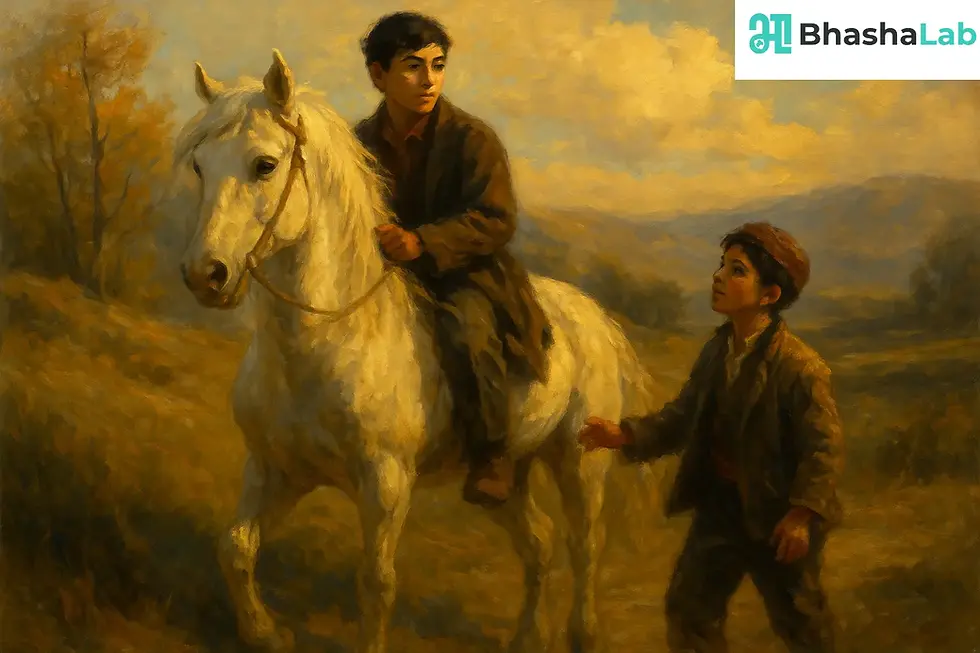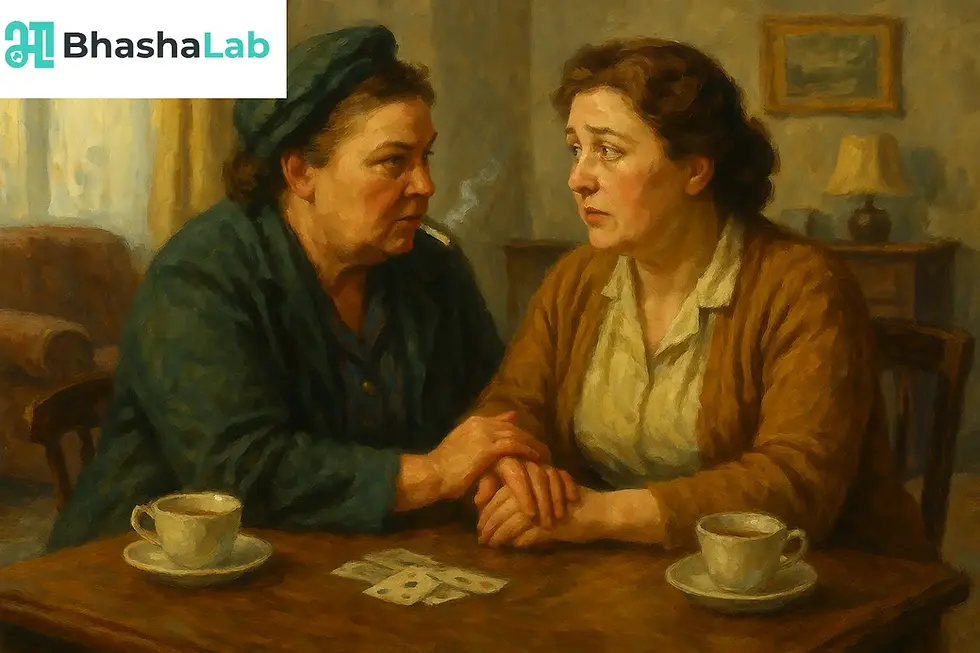1. The Summer of the Beautiful White Horse - Class 11 - Snapshots
- Jul 7
- 5 min read

Author: William Saroyan
Textbook: Snapshots
Genre: Short Story / Fiction
Summary
This short story, narrated by a nine-year-old boy named Aram, recounts a memorable summer adventure involving his cousin Mourad and a stolen white horse. The boys belong to the Armenian Garoghlanian tribe, which is known for its strict honesty and pride despite being poor. One morning, Aram is woken up by Mourad, who has mysteriously acquired a beautiful white horse. Aram is shocked but tempted, and the two ride the horse joyfully. Mourad, who is considered eccentric, claims to have a special way with horses. Aram eventually suspects the horse is stolen, which Mourad vaguely denies. They hide and ride the horse for two weeks until they meet the horse’s real owner, John Byro. Byro is astonished but refrains from accusing them out of respect for their family’s reputation. Feeling guilty yet proud, the boys return the horse secretly. The story blends humour, childhood innocence, and moral conflict, showing how values of honesty can prevail even in the face of temptation.
Character Sketch
Mourad:
A lively and imaginative 13-year-old, Mourad is adventurous and deeply connected to animals. Though poor, he has a wild spirit and is considered “crazy” by the family. He believes he has a special connection with horses and dogs and often acts on impulse. Despite stealing the horse, he shows respect and affection toward it and eventually returns it, preserving the family’s honour.
Aram:
The 9-year-old narrator is innocent, curious, and loyal to his cousin. He is caught between his admiration for Mourad and the strong values of honesty his tribe upholds. He initially tries to justify the act but gradually realises the importance of returning the horse. Aram represents the moral development of a child coming of age.
Themes
Theme | Description |
Honesty vs. Temptation | The boys are tempted by the horse, but their family’s reputation for honesty eventually influences their actions. |
Innocence of Childhood | The story captures the wonder, mischief, and emotional dilemmas of childhood. |
Family and Honour | The Garoghlanian tribe's commitment to honesty is a source of pride and identity. |
Freedom and Wild Spirit | Mourad represents the untamed, imaginative spirit of youth that values joy and adventure. |
✨ Literary Devices
Device | Example | Effect |
Imagery | “The horse stood on its hind legs, snorted…” | Creates a vivid mental picture. |
Humour | Uncle Khosrove’s repeated lines: “It is no harm…” | Adds lightness and exaggeration. |
Irony | Honest boys stealing a horse but not for money | Highlights moral complexity. |
First-person narrative | Narrated by Aram, a child | Makes the story personal and engaging. |
Symbolism | The horse symbolises freedom, desire, and moral test | Reflects internal conflict. |
Title Justification
The title “The Summer of the Beautiful White Horse” is symbolic and nostalgic. It captures the essence of the story — a special summer marked by an extraordinary event in Aram’s childhood. The beautiful white horse stands for fantasy, adventure, and temptation. The title evokes a dreamy tone, hinting at a memorable time that blends joy, conflict, and moral awakening. It aptly summarises the central event and emotional tone of the story.
One-Mark Questions
Why was Aram initially shocked to see Mourad with a white horse?
He knew their family was very poor and could not afford a horse. Also, their tribe was known for its honesty, so he couldn’t believe Mourad had stolen it.
What does Mourad claim about his ability with animals?
Mourad says he has a way with animals. He believes he can understand and control them with kindness.
How does Uncle Khosrove usually react to serious matters?
Uncle Khosrove always shouts, “It is no harm; pay no attention to it,” regardless of the situation. He is impatient and dismissive, even when told his house is on fire.
Why does John Byro not accuse the boys of stealing the horse?
He respects the boys' family’s reputation for honesty. Though he is sure the horse is his, he chooses to believe in their integrity.
Where do the boys hide the horse?
They hide the horse in a deserted vineyard’s barn that once belonged to a farmer named Fetvajian. It has oats and dry alfalfa for the horse.
Three-Mark Questions
Describe how Mourad and Aram differ in their attitudes toward the stolen horse.Mourad is carefree and adventurous. He believes that riding a stolen horse is not truly stealing, as long as they don’t sell it. Aram, though excited, struggles with guilt because he values the family's honesty. He tries to justify Mourad’s actions to himself. This contrast shows Aram’s moral growth and Mourad’s rebellious spirit.
What role does Uncle Khosrove play in the story?
Uncle Khosrove is a comic character who dismisses every problem with “It is no harm.” His exaggerated reactions highlight the family’s strong pride and emotional responses. He adds humour and serves as a foil to Mourad’s eccentricity. Though loud, he reflects the passion and identity of the Garoghlanian tribe.
Why did the boys finally return the horse to its owner?
Though initially tempted to keep it, they return the horse after meeting John Byro. His deep trust in their family’s honesty moves them. Mourad’s pride in their heritage and Aram’s growing awareness of right and wrong guide their decision. They wish to maintain the honour of the Garoghlanian name. It’s a silent act of redemption.
Value-Based Question
What does the story teach us about honesty and personal integrity?
The story shows that even when temptation is strong, personal values and family honour must guide our actions. The boys learn that excitement and adventure must not come at the cost of integrity. Mourad, though eccentric, understands the importance of returning what does not belong to him. Aram realises that one must not take pride in a false act. In the end, doing the right thing brings peace and pride that lasts longer than any temporary thrill.
End
About BhashaLab:
BhashaLab is a dynamic platform dedicated to the exploration and mastery of languages - operating both online and offline. Aligned with the National Education Policy (NEP) 2020 and the National Credit Framework (NCrF), we offer language education that emphasizes measurable learning outcomes and recognized, transferable credits.
We offer:
NEP alligned offline language courses for degree colleges - English, Sanskrit, Marathi and Hindi
NEP alligned offline language courses for schools - English, Sanskrit, Marathi and Hindi
Std VIII, IX and X - English and Sanskrit Curriculum Tuitions - All boards
International English Olympiad Tuitions - All classes
Basic and Advanced English Grammar - Offline and Online - Class 3 and above
English Communication Skills for working professionals, adults and students - Offline and Online
Contact: +91 86577 20901, +91 97021 12044
Mail: info@bhashalab.com
Website: www.bhashalab.com





Comments